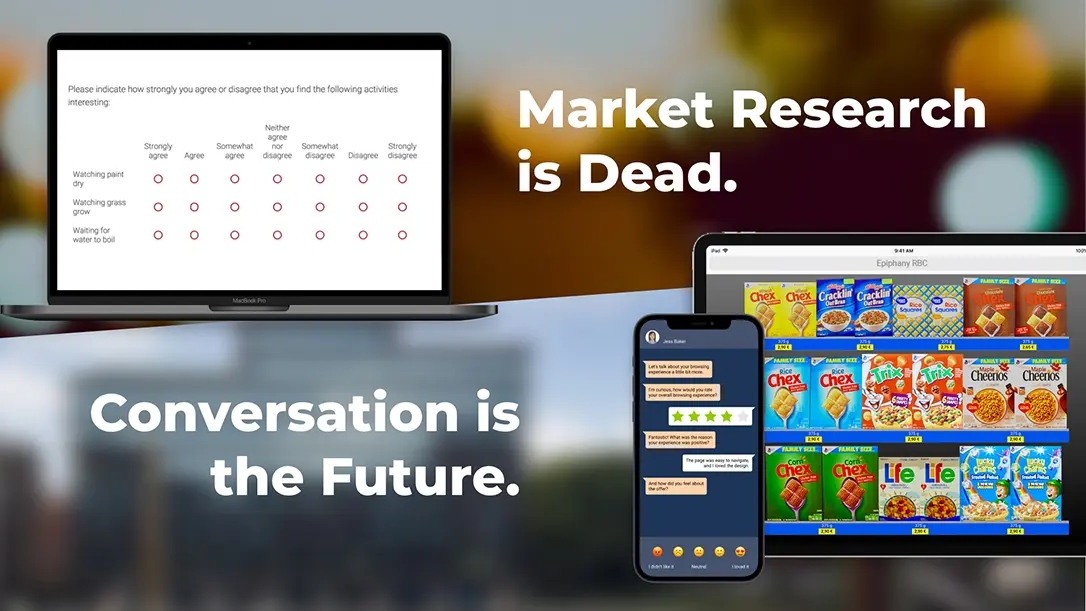Surveys are dying!
Netflix. YouTube. Fortnite. Sleep.
These all have a common purpose.
They are all fighting for the same thing;
Your time.
The whole market research industry is also grappling against these for your attention.
Do we really think our simplistic surveys can compete against refined algorithms which have been engineered by the world’s most valuable data scientists?
And do we all seriously believe that Gen-Z are willing to take part in a 20-minute survey for a quick thank you and small monetary incentive?
No. The next generation are pretty busy people;
PlayStation, TikTok, and Tinder seem more entertaining than their view on the state of the veterinary industry.
I’m sure 20-somethings would rather be watching Travis Scott performing in Fortnite than answering if they’re very interested or somewhat interested in new fishing legislation.
Imagine a teenager telling their friends they spent their weekend giving their opinion on the ergonomics of a new desk chair.
It is a fallacy to believe our industry can continue at this current rate.
We see this crisis unfolding before our eyes.
Lucrative segments are getting harder and more expensive to reach.
Traditional market research is therefore dying. It is tedious and monotonous, yet more pressure is being placed on the respondent from industry CEO’s.
Surveys are getting longer and more repetitive, all leading to higher drop-out rates and less overall panel engagement.
Think about it for a second.
In the last twelve months, how many people in your social sphere have recently discussed their excitement about surveys and questionnaires?
On a scale of 0 to 10, how entertaining was the last survey you participated in?
I bet the above answers were both 0, or you couldn’t recall, right?
Let’s face it, we all have a problem on our hands that we need to address.
We all love those actionable insights. But those insights need to be based on high samples to have any kind of recognition from clients.
And as incidence rates come down dramatically, industry reform needs to occur to ensure we can move forward, or even just continue, to create meaningful and impactful research.
We all see the crisis, but are afraid to call out our worries;
How can we combat the downtrend in data quality and panel engagement?
What is the future?
Of course, there is a silver lining.
The solution to this issue lies in conversationally designed surveys.
Using our unique Conversation Design™ techniques we can start to refresh the stagnant taste of monotony within the research industry.
The ideology is simple.
Take everyday conversations and apply them to surveys.
We take part in these interactions daily.
In bakeries, cafes, supermarkets and bars. We interact with friends, strangers and acquaintances.
We wouldn’t be human otherwise, social interactions are the basis of our community. People are more willing to share their ideas about topics they’re engaged in.
So how hard can it be?
The implementation is difficult.
Combining quantitative and qualitative data has perplexed the industry for years.
This is why these types of disciplines exist; you are either quant or qual, right?
These two expertise have lived separate lives since the conception of the industry.
However, Epiphany’s Conversation Design™ blurs the lines between the two to create a more unified marriage (or civil partnership) of insight.
This ‘holy grail’ of research not only beautifies surveys to increase engagement, respondents enjoy taking part and open up more deeply about brands and products, ultimately leading to a deeper understanding.
Conversation is the future here.
The future is here now, and it’s here to stay.
Traditional 20-minute surveys are dead. They treat every interaction and every human the same.
As researchers, it is our collective responsibility to respond to this industry crisis to ensure the next generation carves out the time in between Netflix, YouTube, Fortnite, or Sleep to take part in your research.
Therefore, it is essential to follow the principles of the Epiphany Conversation Design™ to implement flexibility within the rigidity of your questionnaire.
If you’d like to learn more about applying Conversation Design™ to your research, reach out below.
Bringing Epiphanies to life by looking beneath the surface of business and unveiling powerful consumer insights










 by
by 



